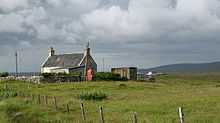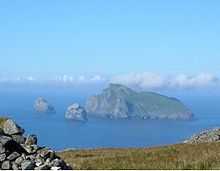Baleshare
| Location | |
|---|---|
 Baleshare Baleshare shown within the Outer Hebrides | |
| OS grid reference | NF788619 |
| Names | |
| Gaelic name | Am Baile Sear |
| Meaning of name | Gaelic for 'east town'. |
| Physical geography | |
| Island group | Uists and Barra |
| Area | 910 hectares (3.5 sq mi) |
| Area rank | 54 [1] |
| Highest elevation | 12 metres (39 ft) |
| Political geography | |
| Sovereign state | United Kingdom |
| Country | Scotland |
| Council area | Na h-Eileanan Siar |
| Demographics | |
| Population | 58[2] |
| Population rank | 56 [1] |
| Population density | 6.4 people/km2[2][3] |
| Largest settlement | Samhla |
| References | [3][4][5] |

Baleshare (Scottish Gaelic: Baile Sear) is a flat tidal island in the Outer Hebrides of Scotland.
Baleshare lies to the south-west of North Uist. Its economics and community were boosted by the building of a causeway in 1962. The 350 m (380 yd) causeway was built by William Tawse Ltd.[6] The island is extremely flat by Hebridean standards, rising to only 12 metres above sea level and known for its long sandy beach. It has a population of 49 living in two settlements: Samhla and Teananachar.
The name means 'east farm' or 'east town'. The 'west town' may have been on land that was said to exist to the west of Baleshare, washed away in the sixteenth century, over which it was possible to walk to the Monach Islands at low tide.[3] The Monachs are some 15 kilometres to the west. Another story suggests there was once a land bridge to Kirkibost, 100 metres to the north.[7] The basis for this seems to be a reference in the Exchequer Rolls for 1542 that the valued rental had been decreased due to encroachment by the sea at some unspecified (presumably recent) date.
Two prehistoric settlements have been uncovered, which contain the remains of a circular stone house and pieces of pottery, bone and metal. In common with other sites in the area, they are threatened by coastal erosion.[8][9]
Notable people from Baleshare
- John Fergusson, Nova Scotia politician.[10]
- Cailean MacQuarrie, Cadet featuring in ITV documentary 'The Merchant Navy'.[11]
Footnotes
- ↑ 1.0 1.1 Area and population ranks: there are c. 300 islands >20ha in extent and 93 permanently inhabited islands were listed in the 2011 census.
- ↑ 2.0 2.1 National Records of Scotland (15 August 2013) (pdf) Statistical Bulletin: 2011 Census: First Results on Population and Household Estimates for Scotland - Release 1C (Part Two). "Appendix 2: Population and households on Scotland’s inhabited islands". Retrieved 17 August 2013.
- ↑ 3.0 3.1 3.2 Haswell-Smith, Hamish (2004). The Scottish Islands. Edinburgh: Canongate. ISBN 978-1-84195-454-7.
- ↑ Ordnance Survey. Get-a-map (Map). 1:25,000. Leisure. Ordinance Survey. Retrieved 21 August 2013.
- ↑ Mac an Tàilleir, Iain (2003) Ainmean-àite/Placenames. (pdf) Pàrlamaid na h-Alba. Retrieved 26 August 2012.
- ↑ "Baleshare Causeway". Gazetteer for Scotland. Retrieved 2007-08-18.
- ↑ "Western Isles: Baleshire". BBC Scotland. Retrieved 2007-08-18.
- ↑ Jamie Beatson (2007-05-30). "History at risk from erosion by the sea". The Scotsman. Retrieved 2007-08-18.
- ↑ Barber, John (2003) Bronze Age Farms and Iron Age Farm Mounds of the Outer Hebrides. Scottish Archaeological Report 3. Retrieved 18 August 2007.
- ↑ The Canadian parliamentary companion, HJ Morgan (1874)
- ↑ The Merchant Navy. STV.
External links
Coordinates: 57°32′N 7°22′W / 57.533°N 7.367°W
| ||||||||||||||||||||||||||||||||||||||||||||||||||||||||||||||||||||||||||||||||||||||||||||||||||||||||||||||||||||||||||||||||||||||||||||||||||||||||||||||||||||||||||||||||||||||||||||||||||||||||||||
